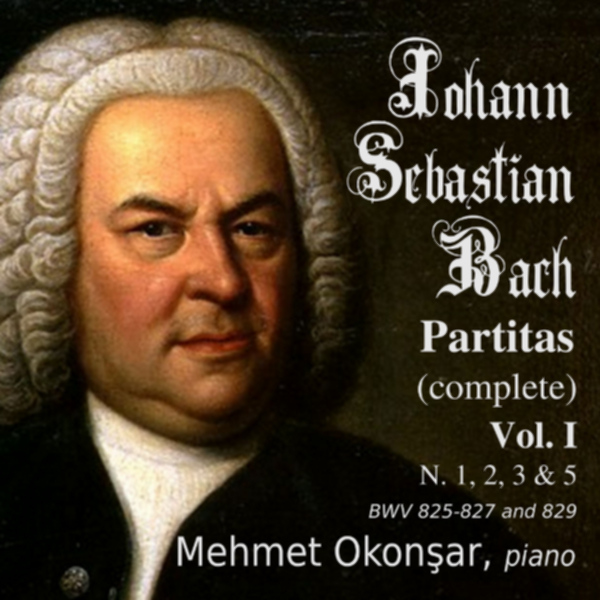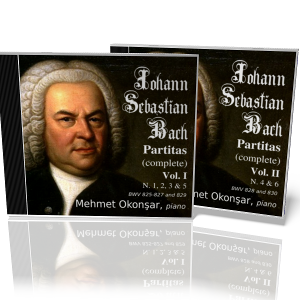
Johann Sebastian Bach
The Complete Partitas BWV 825-830 in two CD set



|
The Partitas by J.S. Bach exemplify for me both the apex and the end of Baroque dance-forms in music, just like the last Beethoven sonatas are the culmination and the closing of the classical sonata form. Nothing else on those forms and designs could have been created after if they had to be original and creative works, not bare imitations. The classical instrumental sonata after the opus 111 by Beethoven and the traditional Menuet or other baroque dance forms in music after these Partitas have gone radical transformations. Only the "essence", not the form neither the mannerisms of those traditional dance-forms are dealt with by Bach. The composer, around 45 at the time, had all the mastery for any kind of instrumental composition as well as polyphonic part writing. Furthermore, he had a full knowledge of all the established music styles of his time. Synthesizing the best of French and Italian masters, he was able to base his own creativity on top of the best of the tradition, without limiting his "sources" to a particular genre or country. The series of six suites or "Partitas" for harpsichord (BWV 825-830) make for the first part of the "Clavier-Ubung". This series was published by the composer in Leipzig between 1726 and 1731, one number each year. The entire collection also appeared in one volume in 1731 as "opus 1". The set was then named "Clavier-Ubung" and Bach named the series "Partitas". In the 17th. and 18th. centuries the term "Partita" had a number of different meanings. Among others, it may be the title for a suite of instrumental dances or pieces with variations. Bach has composed a number of Partitas for organ that are variations on choral themes. The Partitas for harpsichord are designed in the form of the "English Suites" even though Bach did emancipate in many instrumental and compositional aspects. Their structures are richer and more complex. Each Partita begins with a large piece whose title differs in each suite: "Praeludium", "Sinfonia", "Fantasia", "Ouverture", "Praeambulum", "Toccata". The traditional order of the suite for the following dances is conserved in all of them: "Allemande"; "Courante"; "Sarabande"; "Gigue", but Bach inserts diverse movements which he calls "galanteries": minuets, passepied, scherzo, burlesca, rondeau, aria. Many of them do not have a dance-like form. They often take place between the Courante and the Sarabande or elsewhere, thus altering the usual dance-suite succession of movements. There are few other licenses with the traditional dance suites: the Partita N.2 ends with a "Capriccio" instead of the usual Gigue. And the Gavotte of the sixth Partita does not have the typical "gavotte" character. In those Partitas, Bach innovates by taking liberties with the usual (dances) suite form to which he adhered in the English Suites. Along with the instrumental and other harmonic innovations, those Partitas represent the apex of the suite form for harpsichord. Partita N.1 BWV 825 in B-flat major
This Partita of seven movements is the first published by Bach in 1726. Just like the English Suite N.1 it is more straightforward than the following ones. The "Praeludium" is a very popular piece, a short prelude of 21 bars which ressembles to an "invention" with three voices, a soft and charming opening. "Allemande" is a flowing "perpetual-motion" piece where a number of motives appear spread to both hands: arpeggios, scales, melodic fragments etc. One "Italian-style", fast paced "Corrente" on two themes organized as a duet follows and leads to the "Sarabande". The melodic aspect of this Sarabande is closer to the French "Versailles" song types: a noble and straight melodic contour with gracious and numerous ornaments. Menuets (I & II): are two different minuets which complement each other in one "A-B-A" form. The A part is in a French style which reminds the "menuets" by Rameau while the middle one is a polyphony of three parts which contrasts with the other. The "Gigue" is a popular virtuoso piece with non-stop crossing of hands. The left hand (or right, depending on the performer's choice) is in constant motion, jumping high and low on the keyboard over a most regularly peaced right (or left) hand, thus creating a "three-hands" effect which is also favored by Domenico Scarlatti and Jean Philippe Rameau. Partita N.2
BWV 826 in C minor
The second Partita was published by the
composer in Leipzig in 1727. Unlike the other Partitas, this one has
only six movements and ends with a Capriccio instead of the traditional
Gigue. This suite is larger and more polyphonic than the previous one.
The opening "Sinfonia" is built in three parts: "Grave adagio", Andante and Allegro. The opening Grave is in a French overture style, typical with its dotted rhythms, a strong, powerful and dramatic piece. The following Andante is rather Italian in style; it is a sort of vast "cantilena" over a continuous bass line it flows into a two-voice fugato Allegro. In this Sinfonia, Bach synthesizes a number of elements: a French-style overture and an Italian-style Sinfonia. A calm Allemande with a main theme in a canon form follows. The Courante is a French-style Courante with a complex polyphonic writing involving contrary motion and inverted themes. The extensive Sarabande is very similar to an Aria. It is followd by "Rondeau", very much like the ones by Francois Couperin. Instead of the usual Gigue a Capriccio ends the suite. It is a rather brilliant virtuosity piece. A superb three-voice setup where Bach's polyphonic part writing is outstanding. Partita N.3 BWV 827 in A minor
This Partita composed in 1728 starts with a
Fantasia, has the usual seven movements and includes two "galanteries":
Burlesca and Scherzo. It was included, yet in a rather crude form, in
the Clavierbuchlein II composed for Anna Magdalena in 1725.
The starting Fantasia is a large scale two-voice invention. An unique theme is presented in imitation form between the two voices. The Allemande is again a complex polyphonic writing and has very sophisticated rhythmical structure which makes it one of the most refined pieces of the entire set. An Italian style "corrente", fast and gracious. The Sarabande is deep and emotional. Intimacy is all present within the three voices. The "Burlesca" is a free-form "galanterie" style piece as it was, sometimes, customary to insert among the more structured "Allemande - Courante - Sarabande - Gigue" succession. Another "galanterie": "Scherzo" follows it. The Gigue is solemn yet brilliant with panache, as often the case with Bach's Gigue's, the second part is articulated with the inverted theme. Partita N.4 BWV 828 in D major
The fourth Partita, published by Bach in
1729 in D major, a key often employed by the composed for brilliance,
shine and grandeur.
This Partita starts with a French-style "Ouverture" in two parts. A first slow movement, including all French-style ornaments: dotted rhythms, fast lines etc. followed by a fast part in fugato style. There is no getting back to the first section. A theme is exposed three times and generates all the fast paced movement with its imitative repetitions. The imitation style writing is brilliantly alternated with some secondary elements in a syncopated rhythm. A very rich and polyphonic writing makes that Allemande one of the most elaborated ones of the series. A highly diversified rhythmical structure is the key for a beautifully designed melodic line. The French-style Courante in three voices with its theme inverted in the second part follows. The original form and its inversion are mixed in some places, making this dance movement a summit in polyphonic music writing. One joyous syncopated theme is the main ingredient for this "galanterie"-like "Aria". There is a high rhythmic intensity in this vocal-like Sarabande. The contrast between the flowing and even animated melodic line and regularly progressing bass-line is beautiful. One sober and noble Menuet close to the French-style "a la Rameau" flows into the Gigue. This superb piece is in the unusual 9/16 time. The first part exposes an energetic theme in a fugato style. The second part starts with a more fluid theme. The piece develops and concludes with the superposition of both themes. Partita N.5 BWV 829 in G major
With this Partita, published in 1730, Bach
interposes two "galanteries" between the Sarabande and the Gigue.
The opening movement, "Praeambulum" is a brilliant, virtuosity Toccata with fast lines, scales and arpeggios, hands crossings, arpeggiated chords and so on. One rich and ornamented Allemande displays, again great variety in rhythmical elaborations. The Courante is an Italian-style "corrente" with fast and flowing lines on staccato bass notes this disposition is inverted in the second part. Follows a more "static", somehow introverted Sarabande. The menuet masterly plays on alternations between 6/8 and 3/4 time signatures, however, the time signature following the common practice of the time does not change. The piece starts with a compound double meter of 6/8 implicitly present and each phrase ends with a typical 3/4 (simple triple meter) Menuet cadenza. The "Passepied" is agile and fast, yet seldom employed dance on a single theme. The Partita ends as usual with the Gigue. A vast fugato-style one, built on two parts with different themes, both juxtaposed at the end. One brilliant virtuoso piece. Partita N.6 BWV
830 in E minor
This ultimate Partita, which appeared in a
less elaborated form in the Clavierbuchlein of Anna Magdalena in 1725
has been published in its present form in 1730.
A large, "real" Toccata -in its own- opens the suite. Improvisatory style opening and closing sections around one extensive fugato development in three voices composes that extensive piece. Deep and precise rhythmical elaborations make the following Allemande flow with unusual grace and variety. If one is to follow the traditions of XVII. century musical performance, many rhythms need to be performed differently than notated. Then again one Italian-style "corrente" with the unusual three-octaves long running scales at the end of each section. The next "Air" is a "galanterie" movement which somewhat reminds a Gavotte. A simple but effective piece full of energy. The Sarabande of this Partita can be considered to be the most elaborated and emotionally involved with the entire series. The improvisatory style is always present and the instrumental elaboration is at its highest. The title "Tempo di gavotta" of the next piece may mean "this is not a (real) Gavotte but a free-form piece with the rhythmical elements of the dance". Anyway, it is a refreshing interlude between the very dramatical Sarabande and the equally intense Gigue. One superb and very arduous piece. Complexe in writing, performing and even listening. A fugato in three voices with a very "modern" theme involving many "forbidden" melodic steps like the diminished seventh in abundance and in succession.
|
|||||||||||||
| |
|||||||||||||
| |
|||||||||||||
|
|
|||||||||||||
|
|
|||||||||||||
|



